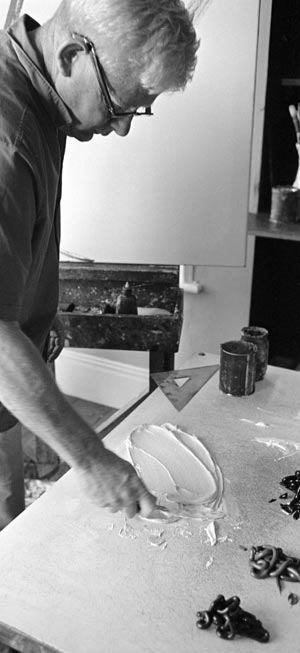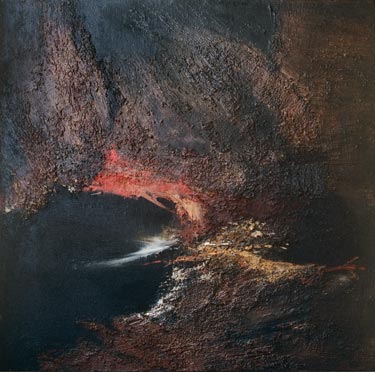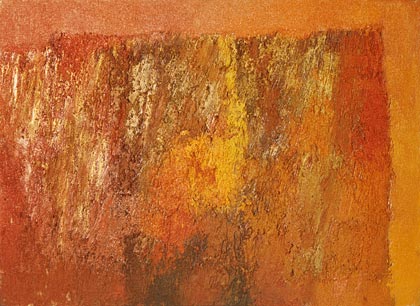James Boswell – A Familiar Stranger

It is thirty-five years since James Boswell first exhibited here, with the London Group; but such has been the course of the intervening years, such the change in his work during the last two, that he comes amongst us, at 55, as a newcomer.
So far are we from Renaissance ideals that the world nowadays deeply mistrusts one who dares to move from his recognised cubbyhole. The professional journalist, the musician who moves with equal ease through Bartok and traditional jazz – such as these are held suspect. In the visual arts the painter-illustrator is tolerated if, as with a Lautrec or Ben Shahn, the two activities can be seen to be extensions of each other; where there is a complete break between them, prejudice remains. It is to this latter class that Boswell, known hitherto mainly as a draughtsman, belongs. As an imaginative reporter of and commentator on life, he has been deeply ‘committed’ – both in the direct, political sense and in the more general, humanistic sense of having taken for his subject man and his (usually urban) environment. As a painter, Boswell is a solitary; his work is non-figurative, subjective, autonomous.
He was born in Westport, New Zealand – a small port for the rich coal mines inland. ‘The sea pounds away at it. Rainfall is 120 inches per annum and it all falls on corrugated iron roofs.’ School in Auckland, then trying to learn to draw by correspondence course, evening classes, reading Ruskin and finally the local School of Art. When he was eighteen he badgered the family to come to London and by 1925 he was at the Royal College of Art. Rothenstein threw him out (‘Don’t dare to come back here until you can do better than that’), but the College actually gave him a fourth year Exhibition later, notwithstanding a tendency to fauvism and a propensity for Paris whenever he could get there.
For some years he showed and sold landscapes and seascapes but this tenuous existence vanished in the Depression. In 1932 he rolled up his canvases, did the round of the agencies and has never had to look for a livelihood since. Now began his association with left-wing politics: lithographs and illustrations for pamphlets, banners for hunger marchers, the Artists’ International Association. His work, he says, ‘became gradually worse and worse in this period, largely due to a confusion in my own mind about its purpose’. In 1941 he got himself into the Army and the Middle East, had time on his hands and drew a lot better (there are drawings in the Imperial War Museum), was transferred to the Ministry of Information and then to ABCA. In 1947 he joined Lilliput as Art Editor for three ‘very crazy, drunken years in Fleet Street’.

After the old Lilliput had been done to death, and its editorial team disposed of, one of the clever advertising men bought in said of the illustrators who had previously appeared in its pages; ‘The trouble is they would put in all the blackheads; of course, they just hated people’. Such a misapprehension of Boswell’s sympathies seems as profound as the comment’s cosy English provincialism. Compared with the bitter savagery of George Grosz, who was and is the biggest single influence on Boswell as a draughtsman, the latter’s graphic work has a thoughtful objectivity about it. That Boswell made Grosz his mentor is an indication, however, of his refusal to accept the inter-war parochialism of this country; and it may be noted that when, in 1952, he returned to painting, it was to the abstraction of ‘inner necessity’ as Sir Herbert Read has called it - an abstraction springing from Kandinsky and German expressionism rather than the so-called ‘hard-edge’ school springing from the architectonic-constructivist ideal of Mondrian – that Boswell finally came.
It was not a sudden thing. He felt unable, at a leap, to join the race at the point reached by his contemporaries. Only by working through the natural development of his ideas and technique did he feel it possible to avoid superficiality and a clever kitsch. He went back to art school for five hard years; he had weekly sessions drawing from the model in his own studio; he shut himself up for days at a time to work on still-lifes and nudes and landscapes. Most of this was straight realism – not through any powerful conviction about realism as a mode but because it seemed like the right way to learn. Most too, he destroyed, though some found its way into R.A. and other mixed exhibitions.
There was a struggle to eliminate the linear, graphic element, in which he had been so completely at home; the struggle to eliminate literature; the struggle to get beyond the traditional, painterly objectives to the autonomous thing-in-itself that exists by its own laws. Looking back now, Boswell recalls several experiences that suggested a way ahead. There was a visit to Chartres around 1956 when the glass spoke of tone/colour relationships not to be found in traditional painting. There was the first American show at the Tate, when Boswell sat, hypnotized, for an hour in front of Pollock. The first abstracts followed: green and blue, very gay, rather sweet. Perhaps De Staël* came into it here for the next – near monochromatic – structures on a white ground were built up of rectangular components. There followed a schizophrenic divide: white on the left, black on the right. Boswell again ceased work for a time.
In the early months of 1961, he began again, this time with a new technical apparatus that included the use of sand and metallic paint. At last he felt the material was doing what he intended it to do, that the paintings said very directly what he was feeling. Throughout the year he worked steadily and this series will be soon on show at the Drian Gallery.
The signposts to an artist’s intentions are traditionally found by reference to his subject matter and iconography, his antecedents and the influences he has accepted, the social context of his times and the formal qualities of his work. In the present state of painting it is not always easy to use these with clarity, and doubly difficult in the case of a painter appearing before us, to all intents and purposes, for the first time. Perhaps it is easier, to start with, to state what Boswell’s paintings are not. Though free abstractions, they eschew the Jove-like gestures of a Soulanges or a Kline, taking their time to make their point.
Though contemplative, however, they quite lack the luminous spatial sense of a Francis or the transcendental serenity of a Rothko, their gnarled and knotted surfaces being outward evidence of the artist’s struggle with his material. Though there is an element of anti-art in their disregard for traditional criteria, they are without the wilfulness of a Dubuffet, being closer, in their sensuous regard for the pâte, to some contemporary Spaniards.

Most of these paintings are low in tone, worked over slowly and at length. The surface is coagulated and heavy, piled high in places with pigment and textured with sand, mouvementé and glinting with copper or bronze. These metallic paints have a life of their own, whether used as semi-inert substance or as wholly opaque glazes, flooded on in petrol so that the images they form grow on the canvas like flowers. The paintings are dramas of ebb and flow, of flux, of tensions sometimes resolved into relatively static images placed within the picture frame, sometimes exploding off the canvas with a sudden release of violence. The descriptive equivalents that come most readily to mind are cataclysmic: molten lava, hurtling debris, cosmic storms. Though Boswell is firm that they have nothing to do with the Bomb or, in spite of a taste for science fiction, with outer space, it may be granted that paintings like these could not have been done a decade and a half ago. Each generation and each period, unconsciously if not consciously, finds its own exterior equivalents for the realities of inner conflict.
Boswell says in his slow drawl: “The edge between where you know what you’re doing and where the emotional stuff is clicking away like a power house fascinates me. I like to work as close as possible to that edge. I don’t think these new pictures are ever really finished. I find I can go on working on them in the same way that one would think over an emotional experience – a death, a love affair – and can add to them or reconstruct them. It is the opposite to action painting”.
Michael Middleton
Originally published in The Studio February 1962
* Nicolas De Staël (1914-1955)




